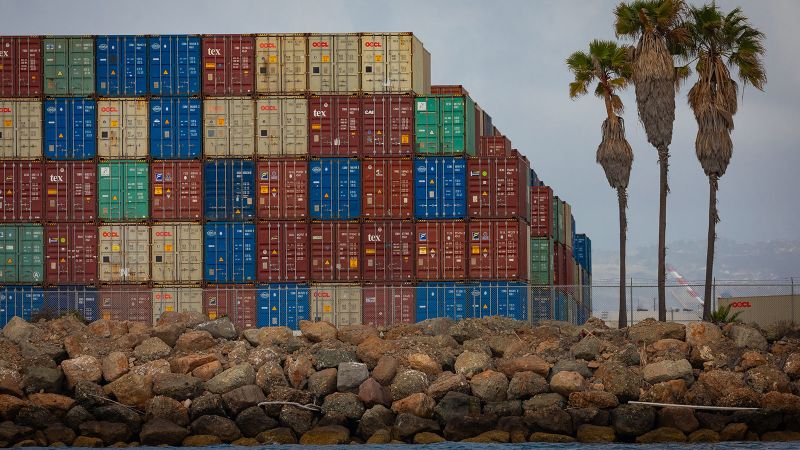The landscape of U.S. ports is presently impacted by a noticeable slowdown in cargo traffic, a situation expected to reverse course rapidly in the coming weeks. With alarming fluctuations in trade dynamics, the trading environment is experiencing turbulence, particularly in light of evolving tariffs associated with Chinese imports. Beginning on Wednesday, cargo shipments from China bound for the United States will be subjected to a 30% tariff, a significant reduction from the previous staggering rate of 145% that had been enforced for a period of six weeks. This tariff rollback comes as part of a strategic de-escalation agreement reached between the United States and China, aimed at reducing the crippling tariff rates for an interim period of 90 days.
Experts in the field are speculating that retailers, with an eye on the upcoming holiday season, may choose to advance their cargo orders during this temporary lull, thereby rushing to bring in inventory ahead of any potential changes in tariff structures. Jonathan Gold, the Vice President of Supply Chain and Customs Policy at the National Retail Federation, posited, “You might see some retailers deciding to bring more products in early to get ahead of that potential expiration if they have the ability to do so.” This strategic move echoes the actions several retailers took prior to the first wave of tariffs, where many opted to stockpile imports in March to mitigate the impacts of the rising tariff rates.
Significantly, China remains a critical trading partner for the United States—servicing needs around clothing, footwear, electronics, toys, and microchips. Consequently, any alterations in trade tariffs can have profound implications for businesses that rely heavily on such imports. Flexport, a notable logistics and freight forwarding broker, noted that while they could not predict the full scale of the impending surge following the recent U.S.-China tariff announcement, an uptick in cargo bookings is anticipated. Meanwhile, economist Peter Boockvar of The Boock Report indicated that while the effects of a reduced 30% tariff are still uncertain, there would be retailers keen to exploit the lower rates, resulting in unprecedented ordering patterns within the next 90 days.
Despite these expectations, current projections from West Coast ports indicate that there will still be a significant decline in both the number of ships docking and the volume of cargo this month. Gene Seroka, Executive Director of the Port of Los Angeles, indicated a forecasted reduction of approximately 20% in ship calls and about 25% in cargo volume by the close of the month. Furthermore, the Port of Long Beach also reported a notable 35% to 40% reduction in cargo shipments and noted that a Friday milestone saw a lengthy pause in shipments from China.
As it stands, the Southern California marine traffic indicates a shortfall of 17 ships compared to usual figures expected through mid-May. The Port of Seattle echoed these concerns by witnessing diminished activities at its docks; a sign of the abnormal market conditions that have persisted since the onset of the pandemic. The Northwest Seaport Alliance, covering both Seattle and Tacoma, forecasts a volume drop between 8% and 15% compared to typical operational periods, with vessels arriving from China carrying 17% less cargo than expected.
While analysts predict an influx of goods may soon commence, they also stress that tariff reductions do not erase the adverse effects caused by previous implementations. The Northwest Seaport Alliance emphasized concerns regarding market uncertainties, cargo fluctuations, and the ongoing ramifications of tariffs that continue to plague both supply chains and the jobs dependent on them. Significantly, it highlights the necessity of maintaining consistency for a fluid supply chain.
Compounding the situation, East Coast ports are equally affected by increased shipping times—estimated at 4 to 6 weeks for vessels traveling from Asia. This delay means that any consequent cargo surge may not be felt until next month, pushing the timeline even further. According to Gold, if retailers begin placing orders now, deliveries might start arriving mid to late June, which would initially see a slowdown followed by an uptick in arrivals leading up to July.
While the transition to a 30% tariff on Chinese imports is a more manageable figure compared to the previous rates, it remains unfeasible for numerous businesses, particularly small ones struggling with inflated costs. The U.S. Chamber of Commerce recently reiterated its position, stating that tariffs remain significantly elevated compared to rates at the beginning of the year and advocating for exemptions for small businesses. Gold noted that larger retailers are in a better position to absorb tariff costs compared to smaller counterparts, emphasizing the vital ongoing discussions surrounding the evolving trade dynamics going forward.
In conclusion, a precarious balance exists between evolving cargo dynamics and tariff regulations, with anticipated surges in shipments coming up against endemic supply chain challenges and ongoing tariff-related uncertainties impacting businesses of all sizes across the U.S.



